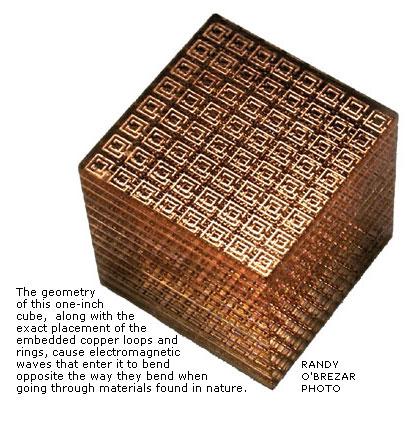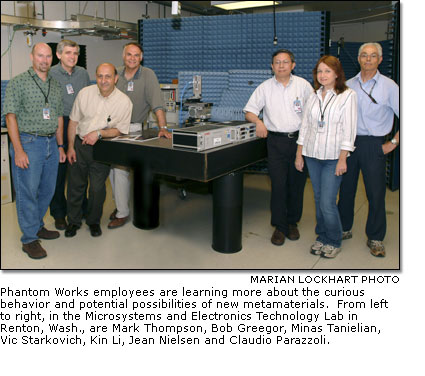| Bending microwaves the ‘wrong’
way
BY TOM KOEHLER
 Boeing
research scientists, working with physicists at the University of California–San
Diego and other universities under a Defense Advanced Research Projects
Agency contract, have been demonstrating something new about the law of
refraction, one of the oldest of the laws of physics. Boeing
research scientists, working with physicists at the University of California–San
Diego and other universities under a Defense Advanced Research Projects
Agency contract, have been demonstrating something new about the law of
refraction, one of the oldest of the laws of physics.
The team’s discoveries involve the fabrication of a new class of artificial
materials called “metamaterials” that bend electromagnetic waves in a
manner not seen in nature. Such a capability could someday prove useful
in the development of significantly smaller, more-powerful and lower-cost
antennas and other electromagnetic devices, and could also lead to the
development of improved lenses capable of focusing light and other forms
of radiation to limits not achievable by normal lenses.
Science magazine cited these discoveries earlier this year in its list
of the top 10 science breakthroughs of 2003. And the June 2004 edition
of Physics Today magazine, the flagship publication of the American Institute
of Physics, showcased a photo of a Boeing-built metamaterial sample on
its cover.
“We have been learning a lot more about the novel properties of electromagnetic
metamaterials,” said Minas Tanielian, manager of Microsystems and Electronics
Technology in Boeing Phantom Works. “Although this technology is still
in its infancy, it is clear that it could have a tremendous effect on
many aerospace products.”
 In
its work under the $5.6 million DARPA contract, the Boeing-led team has
been engineering and fabricating metamaterials to gain a better understanding
of the physics of electromagnetic materials, particularly those that demonstrate
a “negative index of refraction.” Materials found in nature always bend
electromagnetic waves in the same direction, giving those materials a
“positive index of refraction.” In
its work under the $5.6 million DARPA contract, the Boeing-led team has
been engineering and fabricating metamaterials to gain a better understanding
of the physics of electromagnetic materials, particularly those that demonstrate
a “negative index of refraction.” Materials found in nature always bend
electromagnetic waves in the same direction, giving those materials a
“positive index of refraction.”
“Our objectives have been to improve existing tools for modeling and
simulating more complicated patterns and lattices in the metamaterials,
to fabricate the materials using various materials and processes, to test
the electromagnetic behavior of the metamaterials in the laboratory and
in aerospace environments, and to identify applications where such materials
can make a big difference,” Tanielian said.
thomas.j.koehler@boeing.com
|
How
it works
If you’ve ever wondered why a drinking straw appears to bend at
the point it enters water in a glass, then you’ve thought about
the law of refraction, first derived by Willibrord Snell in 1621.
The Dutch physicist was the author of Snell’s Law, which describes
the angle of refraction produced by the slowing of light through
water, glass and other ordinary material.
Physicists measure the bending of light, microwaves and other forms
of electromagnetic radiation through a material by its “index of
refraction.” The bigger a material’s index, the slower light travels
through it, and the more it “bends,” or changes direction when going
from one material to another. As it interacts with the atoms and
molecules in materials found in nature, electromagnetic radiation
always is deflected in the same direction, giving those materials
a “positive index of refraction.”
However, in 1968, a Soviet physicist named Victor Veselago hypothesized
that a material with a negative index of refraction, or “left-handed
material,” could possibly exist, without violating any of the laws
of physics. In 2000, physicists at the University of California
in San Diego, building on work done at the Imperial College in London
and other research, used a combination of copper rings and wires
etched on a circuit board to create an experimental metamaterial
that confirmed a microwave beam would undergo negative refraction
at the interface between the metamaterial and air—unlike any existing
material.
Since then, the Boeing-led team, using sophisticated microfabrication
and simulation techniques, has produced three-dimensional lattices
of copper loops and rings embedded in a nonconducting material that
create an electromagnetic field that deflects light in the opposite
direction of natural materials. In the process, they have learned
a great deal about the curious behavior, and potential possibilities,
of these left-handed materials.
“Through this promising research, we are able to explore new frontiers
in optical and electromagnetic effects that could yield much higher-performance
and lower-cost communications, surveillance and computer systems
in the future,” said Minas Tanelian of Boeing Phantom Works.
|
|

